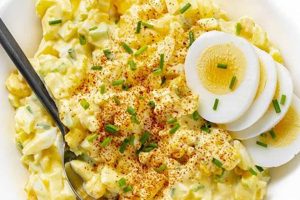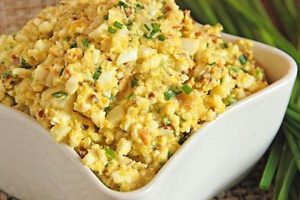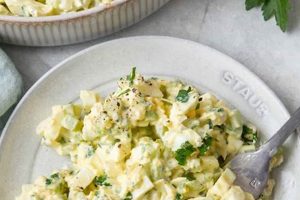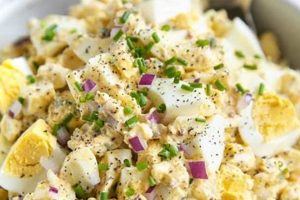Cooked elbow macaroni, combined with mayonnaise and hard-boiled eggs, forms the foundation of this classic dish. Common additions include celery, onion, and various seasonings such as mustard, vinegar, salt, and pepper. Variations can incorporate different vegetables like bell peppers or peas, cheeses, meats like ham or tuna, and alternative dressings. A simple recipe might involve combining cooked macaroni, chopped celery, onion, hard-boiled eggs, mayonnaise, mustard, vinegar, salt, and pepper.
This dish offers a versatile and convenient meal option, suitable for picnics, potlucks, and everyday lunches or side dishes. Its adaptable nature allows for customization to suit individual preferences, dietary needs, and available ingredients. Historically, macaroni salads gained popularity in the early 20th century as refrigeration became more common, making mayonnaise-based salads safer and easier to prepare. The combination of affordable ingredients and satisfying flavors contributed to its widespread appeal.
This exploration will delve deeper into diverse recipe variations, discuss ingredient selection and preparation techniques, and offer tips for achieving optimal texture and flavor.
Tips for Exceptional Macaroni Salad
Achieving a perfect macaroni salad involves attention to detail in ingredient selection and preparation techniques. The following tips offer guidance for creating a flavorful and satisfying dish.
Tip 1: Cook Macaroni Properly. Macaroni should be cooked al dente, or slightly firm to the bite. Overcooked macaroni can result in a mushy texture. Rinse cooked macaroni under cold water to stop the cooking process and maintain a firm texture.
Tip 2: Use Fresh, High-Quality Ingredients. Fresh vegetables and high-quality mayonnaise contribute significantly to the overall flavor and quality. Opt for crisp vegetables and a mayonnaise brand that aligns with individual preferences.
Tip 3: Properly Prepare the Eggs. Eggs should be cooked until the yolks are firm but not dry. Overcooked yolks can develop a greenish tinge and a less desirable texture. Ice baths can facilitate peeling and prevent overcooking.
Tip 4: Balance Flavors. A well-balanced macaroni salad incorporates a harmonious blend of tanginess, sweetness, and savory notes. Adjust the amounts of mustard, vinegar, and seasonings to achieve the desired flavor profile.
Tip 5: Chill Thoroughly Before Serving. Chilling allows the flavors to meld and enhances the overall experience. Refrigerate the salad for at least two hours before serving to allow the ingredients to marry.
Tip 6: Consider Textural Variety. Adding ingredients like chopped nuts, crumbled bacon, or diced pickles can introduce interesting textural contrasts and elevate the dish beyond the basic recipe.
Tip 7: Adjust Dressing Consistency. The desired consistency of the dressing can be adjusted by adding more or less mayonnaise. A thinner dressing is ideal for coating the macaroni evenly, while a thicker dressing creates a creamier texture.
By following these tips, one can ensure a delicious and satisfying macaroni salad that complements any meal or occasion.
These guidelines offer a starting point for creating a personalized version of this classic dish, adaptable to individual preferences and dietary needs. The subsequent conclusion will summarize key takeaways and suggest further exploration of macaroni salad variations.
1. Elbow Macaroni
Elbow macaroni’s unique shape and characteristics make it the preferred pasta for classic macaroni salad. Its curved tubes hold dressings effectively, contributing to a cohesive and flavorful dish. Understanding the role of elbow macaroni in these recipes is essential for achieving desired results.
- Shape and Texture:
The curved, hollow shape of elbow macaroni allows it to capture and hold the mayonnaise-based dressing, ensuring even distribution of flavor throughout the salad. Its smooth texture provides a pleasant mouthfeel that complements the other ingredients. Other pasta shapes, while usable, lack the same ability to retain dressing and create a harmonious blend.
- Cooking Properties:
Elbow macaroni cooks evenly and relatively quickly, making it convenient for salad preparation. Achieving the perfect al dente texture is crucial; overcooked macaroni becomes mushy and negatively impacts the salad’s overall quality. Its ability to absorb flavors from the dressing during chilling further enhances its suitability.
- Visual Appeal:
The consistent size and shape of elbow macaroni create a visually appealing presentation in macaroni salad. The uniformity contributes to a balanced aesthetic, while the small tubes provide a suitable canvas for the colorful vegetables and other ingredients.
- Cultural Significance:
Elbow macaroni has become synonymous with macaroni salad in many cultures. This association is deeply ingrained in culinary tradition, reinforcing its position as the quintessential pasta for this dish.
The choice of elbow macaroni is not arbitrary; its specific properties contribute significantly to the texture, flavor, and overall success of macaroni salad recipes with egg. The ability to hold dressing, the even cooking properties, and the pleasing visual appeal all contribute to the dish’s widespread popularity and enduring status as a classic.
2. Hard-boiled Eggs
Hard-boiled eggs constitute a foundational ingredient in macaroni salad, contributing significantly to its flavor profile, texture, and nutritional value. Their presence elevates the dish beyond a simple pasta salad, adding a layer of richness and complexity. Understanding the multifaceted role of hard-boiled eggs is crucial for appreciating their importance in these recipes.
- Nutritional Contribution:
Hard-boiled eggs introduce a valuable source of protein and essential nutrients to macaroni salad. They provide a healthy counterpoint to the carbohydrates from the pasta and the fats from the mayonnaise. This nutritional boost contributes to a more balanced and satisfying meal.
- Flavor and Texture Enhancement:
The creamy yolk and firm egg white offer a textural contrast that complements the softness of the macaroni and the creaminess of the dressing. The subtly savory flavor of hard-boiled eggs enhances the overall taste profile, adding depth and complexity. The yolks, in particular, contribute a richness that balances the tanginess of the dressing.
- Visual Appeal:
The bright yellow yolks and contrasting white of the egg whites create visual interest within the macaroni salad. The pieces of egg dispersed throughout the dish add color and break up the monotony of the pasta and other ingredients, enhancing the overall presentation.
- Versatility in Preparation:
Hard-boiled eggs offer flexibility in preparation methods. They can be sliced, diced, or mashed, allowing for varied presentation and integration within the salad. This adaptability allows for customization based on personal preference and desired aesthetic.
The inclusion of hard-boiled eggs in macaroni salad is not merely customary; it represents a deliberate choice that significantly enhances the dish’s nutritional value, flavor profile, visual appeal, and overall culinary experience. The interplay between the eggs and other ingredients creates a harmonious balance that defines classic macaroni salad.
3. Mayonnaise
Mayonnaise serves as the unifying element in macaroni salad, binding the ingredients and contributing significantly to the overall flavor and texture. Its creamy texture and tangy flavor complement the other components, creating a cohesive and palatable dish. An understanding of mayonnaise’s role is essential for crafting a successful macaroni salad.
- Emulsification and Texture:
Mayonnaise is an emulsion of oil and egg yolks, creating a stable and creamy texture that coats the macaroni and other ingredients. This emulsification process is crucial for achieving the desired consistency and mouthfeel. The viscosity of mayonnaise holds the salad together, preventing it from becoming watery or dry. Without a proper emulsion, the oil and other liquids would separate, compromising the salad’s texture and overall appeal.
- Flavor Profile:
Mayonnaise contributes a tangy, slightly acidic flavor derived from vinegar or lemon juice, balancing the richness of the eggs and the starchiness of the pasta. The subtle umami notes from the egg yolks further enhance the flavor profile, creating a complex and satisfying taste. Different brands and types of mayonnaise offer variations in flavor intensity and tanginess, allowing for customization based on individual preferences.
- Binding Agent:
Mayonnaise acts as the glue that holds the various components of macaroni salad together. Its creamy consistency adheres to the pasta, vegetables, and eggs, ensuring a cohesive mixture. This binding property is essential for preventing the salad from becoming a disjointed collection of individual ingredients. The proper ratio of mayonnaise to other ingredients is crucial for achieving the desired consistency and preventing the salad from becoming overly dry or excessively creamy.
- Variations and Adaptations:
While traditional mayonnaise forms the base for most macaroni salads, variations exist. Some recipes incorporate other emulsified sauces like Miracle Whip or salad dressings, offering a different flavor profile and texture. These adaptations allow for customization and cater to diverse preferences. Furthermore, the addition of ingredients like mustard, herbs, or spices can further enhance the flavor of the mayonnaise base, adding depth and complexity to the overall dish.
The choice and application of mayonnaise significantly influence the final product. From its role as an emulsifier and binding agent to its contribution to flavor and texture, mayonnaise is an indispensable component of macaroni salad. Understanding these facets allows for informed decisions regarding ingredient selection and preparation techniques, ensuring a delicious and satisfying culinary experience.
4. Flavor Balance
Flavor balance in macaroni salad recipes featuring eggs is crucial for a palatable and enjoyable culinary experience. A harmonious blend of contrasting tastes creates a symphony of flavors that elevates the dish beyond a simple combination of ingredients. This balance hinges on the careful interplay of several key flavor components.
- Tanginess:
Tanginess, often derived from vinegar, mustard, or pickles, cuts through the richness of the mayonnaise and eggs. This acidity provides a refreshing counterpoint to the creamy and savory elements, preventing the salad from becoming overly heavy. The level of tanginess can be adjusted to suit individual preferences, but its presence is essential for a well-balanced flavor profile. For example, a Dijon mustard offers a sharper tang compared to yellow mustard, while dill pickle relish provides a milder acidic note. The interplay of these acidic components with other ingredients defines the overall tangy dimension of the salad.
- Saltiness:
Salt enhances the flavors of the other ingredients and provides a savory backdrop. The saltiness should be subtle, accentuating the other tastes without overpowering them. Salt also plays a crucial role in balancing sweetness and acidity. Achieving the correct salt level is essential; too much salt can make the salad unpalatable, while too little can leave it tasting bland. The type of salt used, whether table salt, kosher salt, or sea salt, can also subtly influence the final flavor due to variations in mineral content and crystal size.
- Sweetness:
A touch of sweetness, often from sweet pickle relish or a small amount of sugar, can round out the flavor profile and complement the tanginess. This sweetness should be subtle, acting as a balancing element rather than a dominant flavor. The interplay between sweet and tangy notes is crucial for creating a harmonious flavor profile. For instance, a sweet pickle relish can balance the sharpness of vinegar, while a pinch of sugar can temper the acidity of mustard. This delicate balance prevents the salad from becoming overly sweet or excessively tart.
- Savory Notes:
The savory base of macaroni salad comes primarily from the eggs, mayonnaise, and any additional ingredients like celery, onion, or meat. This savoriness provides a foundation upon which the other flavors build. The inherent richness of the egg yolks and the umami notes present in mayonnaise contribute significantly to this savory dimension. Additional ingredients, such as cooked bacon or ham, can further enhance the savory profile, adding depth and complexity. Balancing these savory elements with the tangy, salty, and sweet components is key to a well-rounded flavor profile.
The delicate balance of these flavor components is essential for a successful macaroni salad. A well-executed balance results in a dish that is both refreshing and satisfying, with each flavor complementing the others. This intricate interplay of tastes elevates the macaroni salad from a simple side dish to a culinary creation that delights the palate.
5. Ingredient Quality
Ingredient quality significantly impacts the overall flavor, texture, and enjoyment of macaroni salad containing eggs. Using superior ingredients elevates this seemingly simple dish, transforming it from ordinary to exceptional. This connection between ingredient quality and the final product manifests in several key ways. Fresh, crisp vegetables like celery and onions offer a brighter, more pronounced flavor and satisfying crunch compared to wilted or older produce. Their vibrant flavors contribute a refreshing counterpoint to the richness of the mayonnaise and eggs. The choice of mayonnaise also plays a critical role. High-quality mayonnaise, typically made with real eggs and oil, possesses a richer flavor and smoother texture than lower-quality alternatives. This richer flavor enhances the overall taste profile of the salad, while the smooth texture contributes to a more luxurious mouthfeel. Similarly, farm-fresh eggs, compared to older commercially produced eggs, boast a deeper, more pronounced flavor and contribute to a better emulsification in the mayonnaise, further enriching the salads flavor and texture. For example, using flavorful, ripe tomatoes adds a burst of sweetness and juiciness, while substituting fresh herbs like dill or parsley for dried versions introduces a brighter, more vibrant flavor dimension. The cumulative effect of these seemingly small choices significantly elevates the final dish.
Furthermore, the quality of dried spices significantly influences the overall flavor profile. Freshly ground spices possess a more potent and nuanced aroma and flavor than pre-ground spices that may have lost their vibrancy over time. Investing in high-quality spices, even in small amounts, can markedly enhance the complexity and depth of flavor in the macaroni salad. This is particularly true for spices like black pepper, paprika, and mustard powder, which are often used to season the salad and add subtle nuances to the flavor profile. Using fresh, high-quality spices allows these nuanced flavors to shine through, adding depth and complexity to the overall dish. Conversely, using stale or low-quality spices can result in a muted or even off-putting flavor, detracting from the enjoyment of the salad. The type of vinegar used also contributes to the overall flavor balance. For example, apple cider vinegar lends a slightly sweeter and more complex tang compared to white vinegar, while white wine vinegar offers a milder, more delicate acidity.
In conclusion, prioritizing ingredient quality is paramount for creating a truly exceptional macaroni salad with eggs. The use of fresh, high-quality ingredients elevates every aspect of the dish, from flavor and texture to overall enjoyment. While seemingly minor, these choices collectively contribute significantly to the final result, demonstrating the undeniable link between ingredient quality and culinary excellence. Investing in superior ingredients, though potentially incurring a slightly higher cost, ultimately yields a far more rewarding and satisfying culinary experience.
6. Texture
Texture plays a crucial role in the overall enjoyment of macaroni salad with eggs, contributing significantly to its sensory appeal. The interplay of various textures creates a dynamic and satisfying mouthfeel. This textural complexity arises from the careful combination of ingredients and attention to preparation methods. The firm, yet tender, bite of al dente macaroni provides a foundational textural element. Overcooked macaroni results in a mushy, undesirable texture, highlighting the importance of proper cooking techniques. The creamy richness of the mayonnaise dressing coats the macaroni, creating a smooth counterpoint to the pasta’s slight chewiness. The inclusion of hard-boiled eggs introduces another layer of textural complexity. The firm egg white provides a pleasant contrast to the creamy yolk, further enhancing the salad’s textural diversity. Consider a macaroni salad with mushy, overcooked pasta, watery dressing, and rubbery eggs. The unpleasant textural experience detracts significantly from the enjoyment of the dish, underscoring the importance of textural balance.
Additional ingredients further contribute to the textural profile. Crisp vegetables, such as celery and onions, introduce a refreshing crunch, contrasting with the softer elements. Incorporating chopped pickles or relish adds a tangy snap, further enhancing the textural interplay. The size and shape of these ingredients also influence the overall texture. Finely diced ingredients create a smoother, more uniform texture, while larger, coarsely chopped ingredients offer a more substantial bite. For example, finely diced celery creates a subtler crunch than coarsely chopped celery, offering a different textural experience. Similarly, crumbling bacon into the salad introduces a crispy element, while shredded cheese contributes a smooth, creamy counterpoint. These variations allow for customization based on individual preferences and desired textural outcomes.
Achieving textural balance is essential for a successful macaroni salad. The interplay of soft and crunchy, creamy and firm, creates a dynamic and satisfying sensory experience. Attention to ingredient selection, preparation methods, and the interplay of different textures elevates macaroni salad from a simple side dish to a more complex and enjoyable culinary creation. The absence of textural variation can result in a monotonous and less appealing dish. Conversely, an excessive number of contrasting textures can create a disjointed and overwhelming sensory experience. Therefore, careful consideration of textural elements is paramount in achieving a harmonious and satisfying final product.
7. Chill Time
Chill time is a crucial element in macaroni salad recipes featuring eggs, significantly impacting flavor development and overall quality. Adequate chilling allows the flavors of the various ingredients to meld and harmonize, resulting in a more cohesive and balanced taste profile. This period of refrigeration also enhances the salad’s texture, allowing the mayonnaise-based dressing to further bind the ingredients and create a desirable consistency.
- Flavor Enhancement:
Chilling allows the individual flavors of the ingredients the tanginess of the dressing, the savoriness of the eggs, the sweetness of any added relish, and the subtle notes of the vegetables to permeate the macaroni and create a more unified and complex flavor profile. Without sufficient chill time, the flavors remain distinct and less integrated, resulting in a less harmonious taste experience. This melding of flavors is particularly noticeable with the acidic components of the dressing, which mellow and integrate more fully with the other ingredients during chilling.
- Texture Optimization:
Refrigeration firms the macaroni and allows the dressing to thicken slightly, resulting in a more desirable texture. The chilled temperature also enhances the crispness of the vegetables, providing a pleasant textural contrast to the creamy dressing and tender macaroni. Insufficient chilling can result in a watery dressing and a less appealing overall texture.
- Food Safety:
Chilling is essential for food safety, especially in macaroni salads containing mayonnaise and eggs, which are susceptible to bacterial growth at room temperature. Maintaining a safe temperature below 40F (4C) inhibits bacterial proliferation and minimizes the risk of foodborne illness.
- Enhanced Sensory Experience:
The cool temperature of a chilled macaroni salad enhances the sensory experience, providing a refreshing contrast to warmer dishes. The chilled temperature also dulls excessive sweetness or acidity, allowing the more subtle flavors to shine through. This effect is particularly noticeable with vinegar-based dressings, which can taste overly sharp when not adequately chilled. The cool temperature also enhances the perception of creamy textures, making the mayonnaise-based dressing seem richer and more luxurious.
In conclusion, chill time is not merely a recommended step but a critical component of successful macaroni salad recipes with eggs. It directly influences flavor development, texture optimization, and food safety, contributing significantly to the overall enjoyment of the dish. Adequate chilling allows the diverse flavors to meld harmoniously, creating a more balanced and nuanced taste profile. The cool temperature enhances the sensory experience, while the textural improvements contribute to a more satisfying mouthfeel. Furthermore, proper chilling is crucial for maintaining food safety and preventing bacterial growth. Therefore, adhering to recommended chill times is essential for maximizing both the flavor and safety of macaroni salad.
Frequently Asked Questions
This section addresses common inquiries regarding macaroni salad recipes incorporating eggs, offering practical guidance and clarifying potential uncertainties.
Question 1: What is the ideal pasta-to-dressing ratio?
The optimal ratio depends on individual preference, but a general guideline is to use enough dressing to coat the pasta thoroughly without making the salad excessively soggy. Start with a smaller amount of dressing and add more as needed to achieve the desired consistency.
Question 2: How long can macaroni salad with eggs be stored safely?
Macaroni salad containing eggs should be refrigerated and consumed within three to five days. Proper refrigeration is crucial to prevent bacterial growth.
Question 3: Can other pasta shapes be substituted for elbow macaroni?
While other small pasta shapes can be used, elbow macaroni is traditionally preferred due to its shape, which holds the dressing effectively. Alternative shapes may alter the overall texture and appearance of the salad.
Question 4: How can one prevent hard-boiled eggs from becoming rubbery?
Avoid overcooking the eggs. Bring eggs to a boil, then remove from heat and let them sit in the hot water for 10-12 minutes, depending on size. Immediately transfer them to an ice bath to stop the cooking process.
Question 5: What are common flavor variations for macaroni salad?
Flavor profiles can be customized with various additions, such as different types of mustard, vinegar, herbs, spices, vegetables (e.g., bell peppers, onions, celery, olives), cheeses, or proteins (e.g., ham, tuna, chicken).
Question 6: How can one make macaroni salad healthier?
Healthier variations can be achieved by using low-fat mayonnaise, incorporating more vegetables, and choosing lean protein sources. Whole wheat pasta can also increase the fiber content.
Understanding these common points of inquiry helps ensure the successful preparation and enjoyment of macaroni salad with eggs. Proper handling, storage, and ingredient selection contribute significantly to the overall quality and safety of the dish.
This concludes the frequently asked questions section. The following section will provide a summary of key takeaways and concluding thoughts regarding macaroni salad recipes incorporating eggs.
Macaroni Salad Recipes with Egg
This exploration has provided a comprehensive overview of macaroni salad recipes incorporating eggs, highlighting key components and their contributions to the dish. From the foundational elements of elbow macaroni, hard-boiled eggs, and mayonnaise to the nuances of flavor balance, ingredient quality, textural considerations, and the importance of chill time, each aspect plays a crucial role in the final product. Proper preparation techniques, ingredient selection, and attention to detail elevate this seemingly simple dish to a satisfying and enjoyable culinary experience. An understanding of these factors empowers culinary enthusiasts to create personalized variations tailored to individual preferences and dietary needs. The adaptability of this classic dish allows for endless creativity and ensures its continued presence in culinary traditions worldwide. The historical context underscores its evolution and enduring appeal, while the practical tips and frequently asked questions address common concerns and offer guidance for optimal results.
Macaroni salad, a seemingly simple dish, represents a complex interplay of culinary principles. Its enduring popularity reflects not only its adaptability and affordability but also the inherent satisfaction derived from a well-executed balance of flavors and textures. Continued exploration of variations and a dedication to quality ingredients promise an enduring appreciation for this classic dish. Further research into regional variations and cultural adaptations can provide a deeper understanding of its significance in diverse culinary landscapes.






